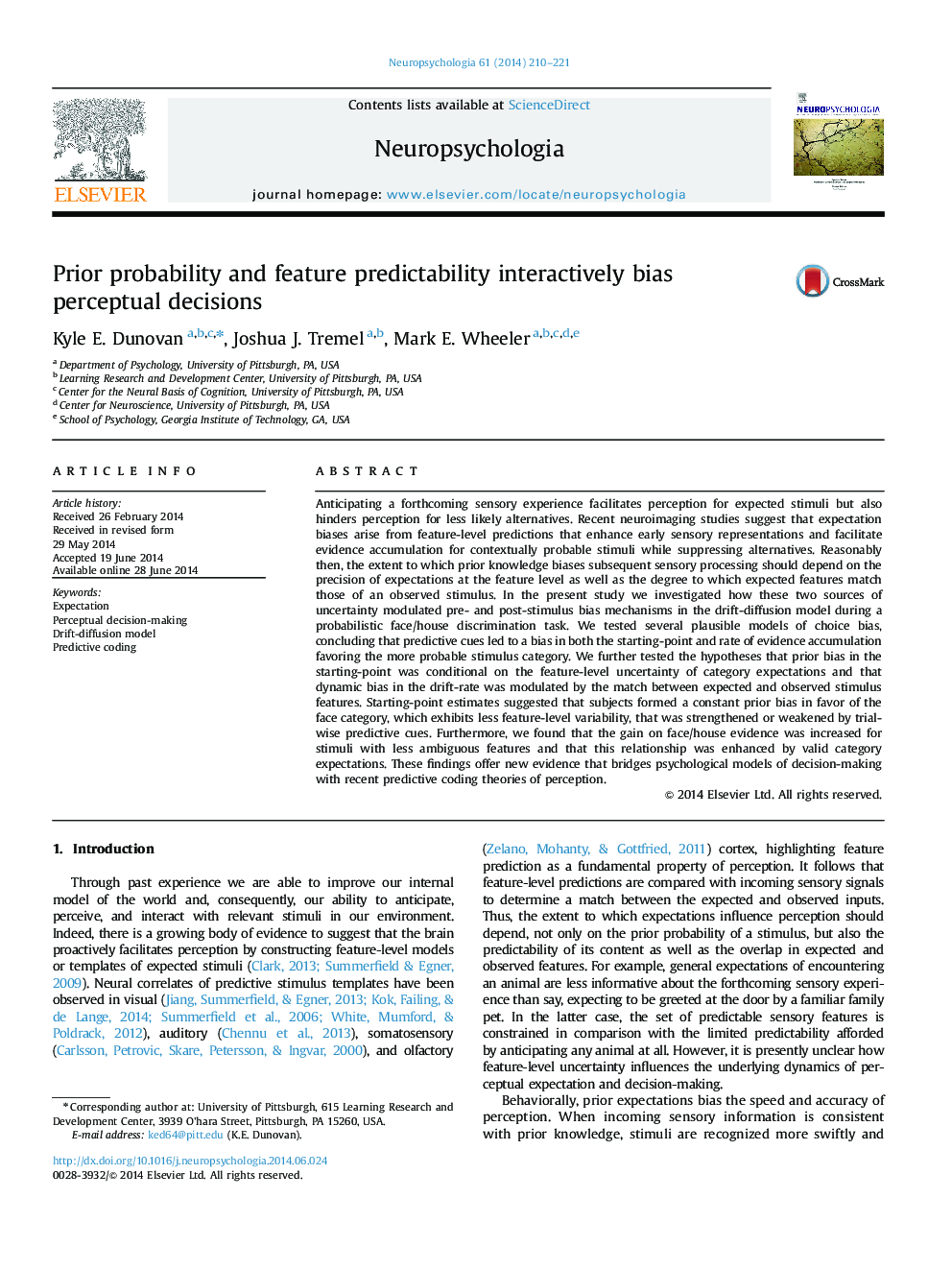| کد مقاله | کد نشریه | سال انتشار | مقاله انگلیسی | نسخه تمام متن |
|---|---|---|---|---|
| 7321176 | 1475592 | 2014 | 12 صفحه PDF | دانلود رایگان |
عنوان انگلیسی مقاله ISI
Prior probability and feature predictability interactively bias perceptual decisions
ترجمه فارسی عنوان
احتمالات پیشین و قابلیت پیش بینی بودن تصمیمات ادراکی متقابل تعاملی
دانلود مقاله + سفارش ترجمه
دانلود مقاله ISI انگلیسی
رایگان برای ایرانیان
کلمات کلیدی
انتظار، تصمیم گیری ادراکی مدل رانش-انتشار برنامه نویسی پیش بینی شده
ترجمه چکیده
پیش بینی یک تجربه حسی پیشین، درک برای محرک های مورد انتظار را تسهیل می کند، بلکه مانع ادراک بعضی جایگزین ها نیز می شود. اخیرا مطالعات نوروفیزیکی نشان می دهد که تعصب انتظارات از پیش بینی های سطح ویژگی ها به وجود می آید که باعث تقویت تظاهرات حسی می شود و تسلیم انباشت شواهد برای محرک های احتمالی محسوب می شود و سرکوب جایگزین ها را تسهیل می کند. به این ترتیب، تا حدی که دانش قبلی دانش واسطه پردازش حس گر بعدی را به دقت انتظارات در سطح ویژگی و همچنین درجه ای که ویژگی های مورد انتظار آنها را با یک محرک مشاهده می کند، بستگی دارد. در مطالعه حاضر، ما بررسی کردیم که چگونه این دو منبع نااطمینانی، مکانیزم پیش فرض و پس از محرک را در مدل ردیابی-افتراق در طی یک کار آزمایشی صورت / خانه مانع می شوند. ما چندین مدل معتبر از تعصب انتخابی را آزمایش کردیم و نتیجه گرفتیم که نشانه های پیش بینی شده منجر به تعصب در هر دو نقطه شروع و میزان انباشت شواهد شده است که از نظر محرک های احتمالی مورد انتظار است. ما بیشتر فرضیه ها را بررسی کردیم که پیش فرض تعصب در نقطه شروع به عدم قطعیت ویژگی انتظارات گروهی بستگی داشت و تعریف پویا در نرخ رانش توسط همبستگی بین ویژگی های محرک انتظار و مشاهده شده تعدیل شد. برآوردهای شروع شده نشان می دهد که افراد بر اساس تعصب مداوم ثابت به نفع دسته چهره بوده اند، که دارای تنوع متغیر است، که با نشانه های پیش بینی شده محاکمه ای تقویت شده یا ضعیف شده است. علاوه بر این، ما متوجه شدیم که افزایش شواهد صورت / خانه برای محرک ها با ویژگی های مبهم کمتری افزایش می یابد و این رابطه با انتظارات گروهی معتبر افزایش می یابد. این یافته ها شواهد جدیدی را ارائه می دهد که مدل های روانشناختی تصمیم گیری را با نظریه های جدید پیش بینی کننده تطبیق ادراک می کند.
موضوعات مرتبط
علوم زیستی و بیوفناوری
علم عصب شناسی
علوم اعصاب رفتاری
چکیده انگلیسی
Anticipating a forthcoming sensory experience facilitates perception for expected stimuli but also hinders perception for less likely alternatives. Recent neuroimaging studies suggest that expectation biases arise from feature-level predictions that enhance early sensory representations and facilitate evidence accumulation for contextually probable stimuli while suppressing alternatives. Reasonably then, the extent to which prior knowledge biases subsequent sensory processing should depend on the precision of expectations at the feature level as well as the degree to which expected features match those of an observed stimulus. In the present study we investigated how these two sources of uncertainty modulated pre- and post-stimulus bias mechanisms in the drift-diffusion model during a probabilistic face/house discrimination task. We tested several plausible models of choice bias, concluding that predictive cues led to a bias in both the starting-point and rate of evidence accumulation favoring the more probable stimulus category. We further tested the hypotheses that prior bias in the starting-point was conditional on the feature-level uncertainty of category expectations and that dynamic bias in the drift-rate was modulated by the match between expected and observed stimulus features. Starting-point estimates suggested that subjects formed a constant prior bias in favor of the face category, which exhibits less feature-level variability, that was strengthened or weakened by trial-wise predictive cues. Furthermore, we found that the gain on face/house evidence was increased for stimuli with less ambiguous features and that this relationship was enhanced by valid category expectations. These findings offer new evidence that bridges psychological models of decision-making with recent predictive coding theories of perception.
ناشر
Database: Elsevier - ScienceDirect (ساینس دایرکت)
Journal: Neuropsychologia - Volume 61, August 2014, Pages 210-221
Journal: Neuropsychologia - Volume 61, August 2014, Pages 210-221
نویسندگان
Kyle E. Dunovan, Joshua J. Tremel, Mark E. Wheeler,
